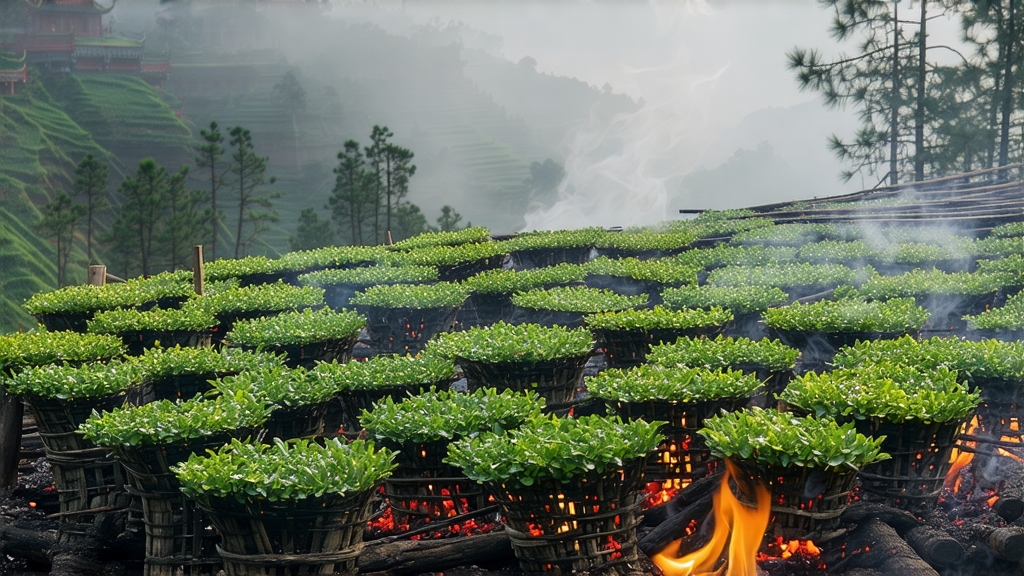
Long before English tea clippers raced across the oceans and Victorian drawing rooms echoed with the clink of bone-china cups, a small village deep in China’s Wuyi Mountains was already perfecting the art of black tea. That village—Tongmu Guan—and the tea it created, Lapsang Souchong, gave the world not only its first fully oxidised leaf but also an aroma so dramatic that poets later described it as “a campfire in a crystal glass.” Today, international drinkers often meet Lapsang through its assertive smoked version, yet few realise that the original, unsmoked “Zheng Shan Xiao Zhong” is a delicate, honeyed brew that quietly shaped the entire genealogy of black tea.
Historical roots
The accepted chronology places Lapsang’s birth in the late Ming Dynasty, around 1568–1644. Legend tells of a passing army that commandeered a tea factory in Tongmu; in haste to dry the leaf before it spoiled, workers spread it over fresh pine fires. The resulting tea, infused with resinous smoke, arrived in the port of Xiamen where Dutch traders bought the entire lot. Europe’s first taste of black tea was therefore Lapsang Souchong, and the name “Bohea” (a corruption of “Wuyi”) became synonymous with luxury in London coffee-houses by 1650. For two centuries the East India Company fought to replicate the tea in Assam and Ceylon, but the original terroir—thin rocky soil, morning mist, and a forest microclimate—proved impossible to imitate.
Terroir and cultivar
Tongmu Guan sits inside a national nature reserve at 27° N latitude, 1,200 m above sea level. The granite cliffs retain daytime heat while cool nightly drifts from the Jiuqu (Nine-Bend) River create a 10 °C diurnal swing, concentrating amino acids in the leaf. Only two Camellia sinensis cultivars are permitted inside the core zone: Xiao Ye Zhong (Small-Leaf Species) and the even rarer Wu Niu Zao, a wild-type bush that germinates from seed rather than cuttings. Because pesticides are banned inside the reserve, the leaf is naturally insect-bitten; the subtle wounding triggers an enzymatic response that later translates into maltol and longan-like sweetness.
Two styles, one leaf
- Traditional smoked Lapsang: After withering over pine embers, the leaves are rolled, fully oxidised, then re-smoked in bamboo baskets above a pinewood fire that burns low for 8–10 hours. The smoke must be cool (28–32 °C) to avoid scorching; master smokers add fresh pine and cypress branches every 40 minutes, timing each addition by listening to the crackle pitch—an auditory skill passed father to son.
- Unsmoked Zheng Shan Xiao Zhong: Here the goal is to showcase the tea’s innate fruitiness. Leaves are withered naturally on bamboo racks inside a pine-free room, oxidised 90 %, then baked at 80 °C with local hardwood charcoal. The result is a russet liquor tasting of dried longan, lychee honey, and a faint mineral note reminiscent of Wuyi rock oolong.
Craft in detail
Plucking begins around Qingming (early April) when two leaves and a bud measure 2.8–3.2 cm. The 8-hour wither reduces moisture from 75 % to 58 %; during this window the leaf loses grassy aldehydes and gains floral geraniol. Rolling is done on 120-year-old pine tables whose surface has absorbed decades of aromatic oils; the gentle bruising lasts 45 minutes, shorter than for Assamica varieties, preserving the smaller leaf’s integrity. Oxidation occurs in deep cedar trays lined with wet cotton; the wood’s phenols drift upward, marrying with the tea’s catechins to create the signature “pine resin & fruit” duet. Finally, a three-stage bake—100 °C, 80 °C, 60 °C—locks in sweetness while lowering water activity to 3 %, ensuring stability for transoceanic voyages.
Grading nomenclature
Western vendors often label every smoked black tea as “Lapsang,” but within Tongmu a strict hierarchy exists:
- Pekoe (pure bud): golden tips, light smoke, cocoa finish
- Souch